Multiplexing is a technique which integrates several signals and transmits it over a single data link. These multiplexed signals are accepted by the demultiplexer which separates them and delivers them to the corresponding node. Multiplexing makes the transmission of multiple signals, economical as we do not have to add a new link for each new signal.
Multiplexing can be performed on analog as well as digital signals. For analog signals, multiplexing has two variations i.e. frequency division multiplexing (FDM) and wavelength division multiplexing (WDM). And on digital signals, time division multiplexing is performed. In this content, we will discuss multiplexing and its types in brief.
Content: Multiplexing & its Types
What is Multiplexing?
Multiplexing is a technique of utilizing the bandwidth of the medium connecting two devices. Consider that the medium connecting two devices has greater bandwidth than the required, in that case, the bandwidth of the medium is wasted.
An efficient system must always utilize all its resources. So, using multiplexing you can utilize the bandwidth of the medium by transmitting several signals over that single medium. A multiplexer combines several signals and transmits it over a single link which is accepted by the demultiplexer. Demultiplexer separates the multiplexed data stream and delivers it to the corresponding output line. In the further section, we will discuss types of multiplexing.
Types of Multiplexing
Multiplexing can be classified into two types Analog Multiplexing and Digital Multiplexing. The analog multiplexing can be further extended to frequency division multiplexing (FDM) and wavelength division multiplexing (WDM). However, the digital multiplexing is classified to time division multiplexing (TDM).
Analog Multiplexing
Analog multiplexing is specially designed for the analog signals.
1. Frequency Division Multiplexing (FDM)
Frequency division multiplexing is the familiar & commonly used multiplexing technique. In frequency division multiplexing signals are modulated over different carrier frequencies.
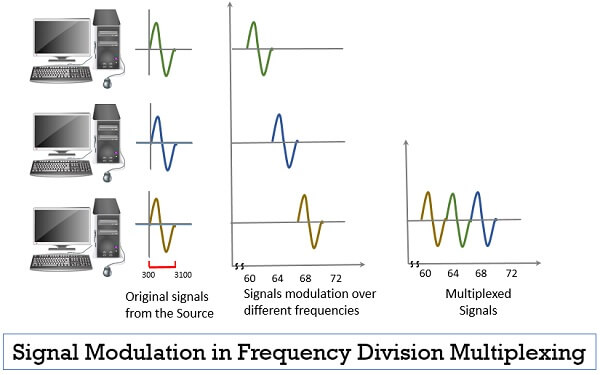 The carrier frequency of each signal is separated in such a way that the bandwidth of each signal does not overlap each other. The best example of FDM is a television signal, you can observe that you can view multiple channels with different frequencies through a single cable.
The carrier frequency of each signal is separated in such a way that the bandwidth of each signal does not overlap each other. The best example of FDM is a television signal, you can observe that you can view multiple channels with different frequencies through a single cable.
The separation between the carrier frequencies leaves an unused bandwidth which we call as a guard band. This is because of guard band, that the bandwidth of multiple signals over a single link does not overlap each other.
In the figure below you can see that we have to mux three information signals from channel 1, 2 and 3. These three information signals are modulated over a different carrier frequencies and these modulated information signals are multiplexed and transmitted over a single link.
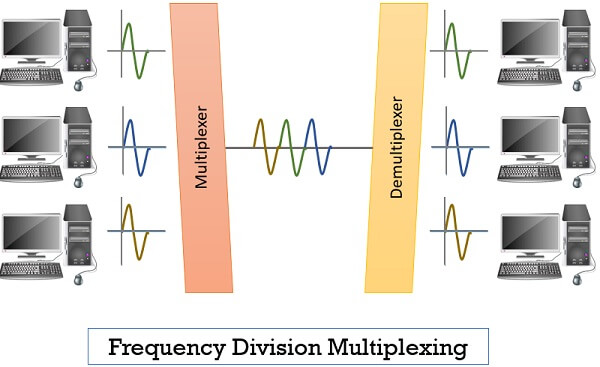 Frequency division multiplexing is possible only when the bandwidth used for the transmitting multiple information signals is greater than the combined bandwidth of all information signals that are to be transmitted.
Frequency division multiplexing is possible only when the bandwidth used for the transmitting multiple information signals is greater than the combined bandwidth of all information signals that are to be transmitted.
2. Wavelength Division Multiplexing (WDM)
The Wavelength division multiplexing work on the basic principle of FDM the only change is that WDM is used for fibre optic communication and the frequencies of the signals to be combined is comparatively very high.
The fibre optic cable is capable of transmitting data at a high rate as compared to the metallic transmission cable. If you transmit only one optical signal then you are literally wasting the rest of bandwidth of the optical fibre.
So using WDM, the narrow band of lights are multiplexed to make a broader band of light and is transmitted over the single link to the receiver where demultiplexer separates the light signal and deliver to the corresponding node.
The WDM is based on the basic principle of physics as we know that when any light falls on the prism it bends the light beam depending on its angle of incidence and its frequency. Multiplexer and demultiplexer can be built using this principle.
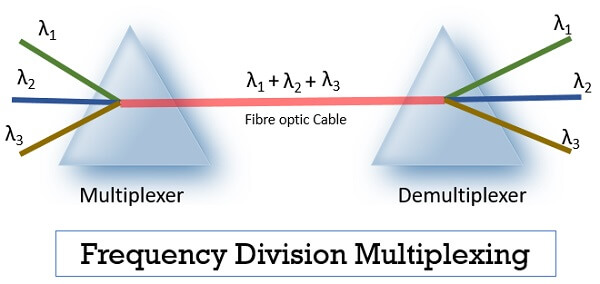 WDM has a variation DWDM i.e. dense wavelength division multiplexing which incorporates more number of signals over a single communication line compared to standard WDM. DWDM multiplexes a large number of signals by spacing them very close to each other.
WDM has a variation DWDM i.e. dense wavelength division multiplexing which incorporates more number of signals over a single communication line compared to standard WDM. DWDM multiplexes a large number of signals by spacing them very close to each other.
Digital Multiplexing
Digital multiplexing is applied to the digital signals
1. Time Division Multiplexing
Time division multiplexing combines multiple signals by dividing in them into a fixed-length time slot. The input signals are divided into time slots of equal length, these slots are then multiplexed and streamed over a single data link.
In the figure below you can observe that the multiplexer is receiving signals from three different sources. Using the TDM technique the bits from each signal are taken in a fixed time slot.
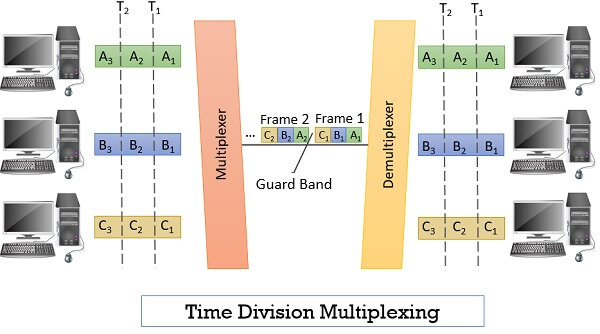 TDM further has two variations synchronous TDM and Statistical TDM. Let us first discuss synchronous TDM.
TDM further has two variations synchronous TDM and Statistical TDM. Let us first discuss synchronous TDM.
a. Synchronous Time Division Multiplexing (STDM)
In synchronous TDM, each source of a signal has an allotted slot in the time frame even if it is not sending any signal. In the figure below you can see that even if the source B has no signal to send, its slot has been reserved in each time frame.
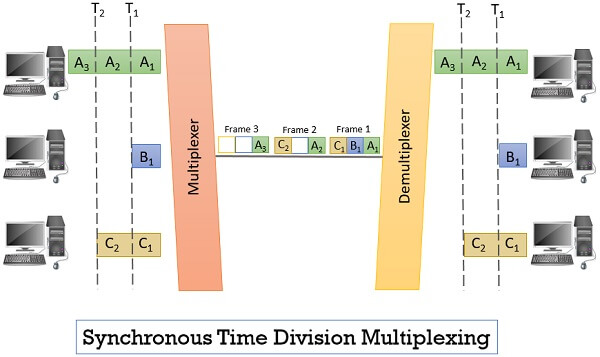 This faster the data rate n times if all the channel has data to be sent. But, this technique can be inefficient if any source has no data to send and still the slot has been reserved for it in each time frame. To remove this inefficiency asynchronous TDM is introduced.
This faster the data rate n times if all the channel has data to be sent. But, this technique can be inefficient if any source has no data to send and still the slot has been reserved for it in each time frame. To remove this inefficiency asynchronous TDM is introduced.
b. Asynchronous Time Division Multiplexing (ATDM)
In Asynchronous TDM or statistical TDM, the allotment of the slot is done dynamically. It means if the source has some data to send it over the communication channel then only the slot is allotted to it in the time frame. The figure below explains to you the working of asynchronous TDM.
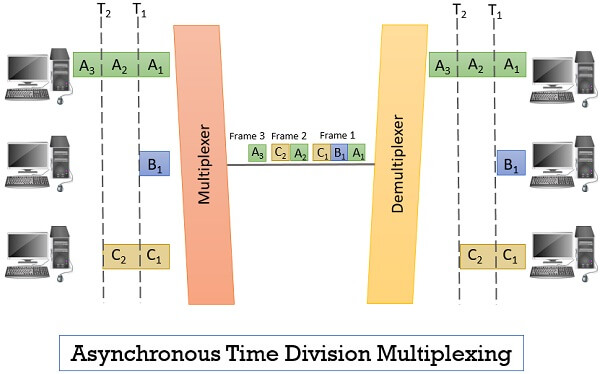
Advantages of Multiplexing
- Multiplexing has made the transmission of multiple signals economical as it combines multiple signals and transmits it over a single communication link.
- With the technique of multiplexing, you can implement various circuits.
- Digital multiplexing allows multiplexing of audio and video signals.
Key Takeaways
- Multiplexing is a technique of integrating multiple information signals over a single data link.
- Multiplexing can be classified as analog multiplexing and digital multiplexing.
- Analog multiplexing is designed for analog signals and it can be classified to frequency division multiplexing and wavelength division multiplexing.
- Digital multiplexing can be implemented only on digital signals and it is further classified to time division multiplexing.
- In frequency division multiplexing, signals to be multiplexed are modulated over different carrier frequencies such that their bandwidth does not overlap each other.
- Wavelength division multiplexing is similar to frequency division multiplexing the only difference is that WDM is used for fibre optic communication.
- In time-division multiplexing, the signals to be multiplexed are divided into fixed-length time slots.
So this is all about multiplexing and its type. We have seen the basic definition of multiplexing and further, we have seen its classification.

Leave a Reply